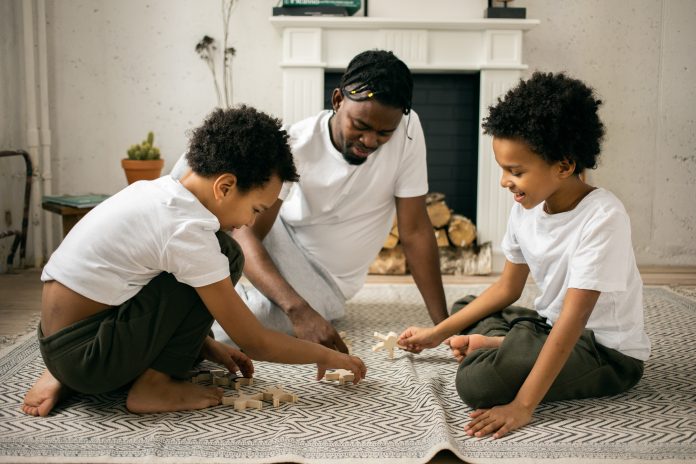
From getting the kids out the door in the morning to volunteering at their school and reviewing homework, parents of school-age children are busy. In the hustle and bustle, it’s easy to forget to take a step back and consciously model prioritizing mental health.
But the need to do so for school-age children is clear.
According to the recently released U.S. Department of Health and Human Services’ Substance Abuse and Mental Health Services Administration (SAMHSA) annual National Survey on Drug Use and Health, in 2021, “14.0% of Black or African American adolescents had a past year major depressive episode.”
There’s a need for change, which may mean having culturally relevant mental health conversations and practices with kids even earlier than some might expect.
Mental health is a really big issue for Black folk. We’re making headway, but there are still challenges.”
DR.ANGELO WILLIAMS, DEPUTY DIRECTOR OF FIRST 5 CALIFORNIA
However, with a shortage of school counselors and psychologists — particularly Black ones — students don’t always have someone on campus to talk to about their problems.
That’s why Dr. Angelo Williams, deputy director of First 5 California — an organization dedicated to changing policy and increasing funding for California families with children prenatal through age 5 — hopes parents will adopt mental health resolutions in the new year — and teach them to their children.
“Mental health is a really big issue for Black folk,” Williams tells Word in Black. “We’re making headway, but there are still challenges.”
Williams came up with three simple resolutions parents should not only follow themselves but also encourage in their kids.
We’re really looking out for parents in between work, daycare, and school events — families just have little time to actually listen,”
DR.ANGELO WILLIAMS, DEPUTY DIRECTOR OF FIRST 5 CALIFORNIA
“They are seemingly simplistic, but they’re extremely important,” Williams says. “To listen, to sleep, and to breathe.”
Some may feel teaching these habits to a preschooler or kindergartener is a bit young. But Williams says it’s innate for children to mimic what they are exposed to, so these three key habits should be a part of that early exposure.
“What we know is that kids don’t necessarily do what we ask them to do,” Williams says. “They model after us. They, do what we do. The habitual practices around mental health at the smallest level is how we pick the three resolutions.”
1. Listen
Interactive and fun games like Simon Says or Freeze Dance are often used by educators to help young children wiggle out their emotions, and get comfortable in a new space. They’re also helpful for boosting students’ listening skills.
Relative to stressful situations, we forget that there’s a superpower related to taking that breath. “
DR.ANGELO WILLIAMS, DEPUTY DIRECTOR OF FIRST 5 CALIFORNIA
But as obvious as it may seem, Williams suggests that a parent who also knows how to listen —whether that be to their young kids or to themselves — is setting their journey through parenthood to potentially be much easier than those who don’t listen as well.
“When we say listen, we’re really looking out for parents in between work, daycare, and school events — families just have little time to actually listen,” William says. “And not just listen to others giving them advice, but listening to their actual physical bodies.”
2. Sleep
“What we know about early childhood education is that it is the scheduling of not just a sleep cycle, but a very consistent schedule where families are allowed to get a good night’s rest every night,” Williams says.
Children have gigantic emotions, and helping them to start to cope with that and to regulate these things are essential not only for battling things related to stress,”
DR.ANGELO WILLIAMS, DEPUTY DIRECTOR OF FIRST 5 CALIFORNIA
The benefits of sleeping include reducing the likelihood of getting sick, as well as helping with attention, concentration, and learning.
Williams says sleeping is restorative, and more sleep may be a solution to more issues than imagined.
3. Breathe
Any preschool or elementary teacher can tell you, little kids do indeed have big emotions. Tantrums and outbursts of anger are evidence of a child’s inability to fully express what they want or need at that moment, or say how they may feel.
“Children have gigantic emotions, and helping them to start to cope with that and to regulate these things are essential not only for battling things related to stress,” Williams says.
Children go through a tremendous amount of emotions on a daily basis, and helping them to self-regulate is one of those major skills in terms of emotional intelligence.”
DR.ANGELO WILLIAMS, DEPUTY DIRECTOR OF FIRST 5 CALIFORNIA
First 5, teaches parents to address these big emotions with Dragon Breathing, a method to practice calmness, give the emotion a name, and move towards a solution for why the child may be upset.
Some lifetime benefits of implementing this method in homes and school environments are better relationships with adults, decreased likelihood of drug abuse, better chances of financial success, and more.
“The breathing. There’s so much research about not only helping children to learn how to breathe,” Williams says. “Relative to stressful situations, we forget that there’s a superpower related to taking that breath.”
Overall, Williams says the key to these resolutions is for them to ensure parents and caregivers give themselves enough space to stop, take a breath, and reset, but also to show their kids that is indeed OK to do those things for yourself, even if the child’s stress is coming from sharing a block of Play-Doh with a fellow kindergartener.
“Children go through a tremendous amount of emotions on a daily basis,” Williams says, “and helping them to self-regulate is one of those major skills in terms of emotional intelligence.”


